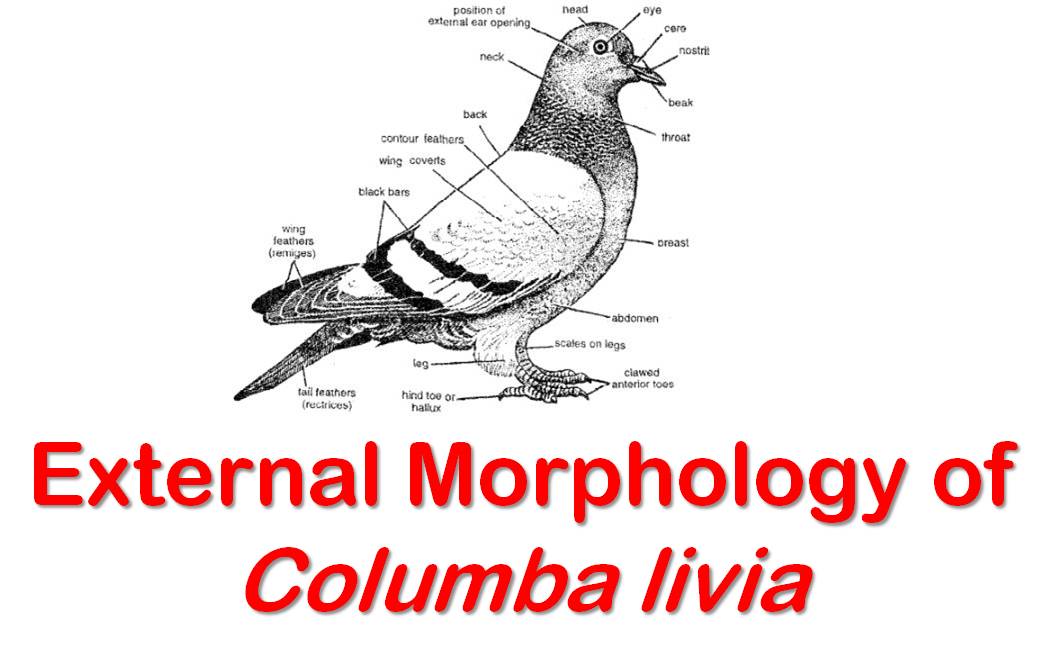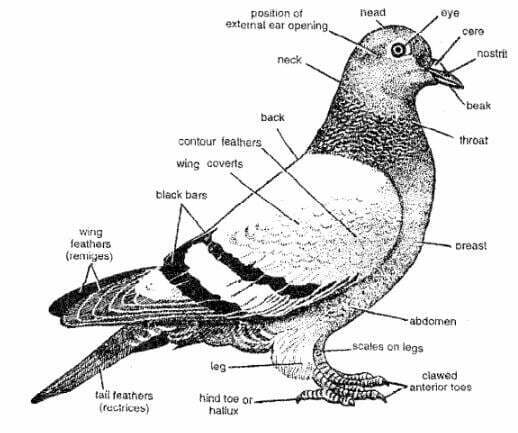Columba livia is the scientific name of the Indian Rock Pigeon. In this article, we will learn about the External Morphology of Columba livia. They are Aves under the Columbiformes order.
Systematic Position
| Kingdom: | Animalia |
| Phylum: | Chordata |
| Class: | Aves |
| Order: | Columbiformes |
| Family: | Columbidae |
| Genus: | Columba |
| Species: |
Columba livia
|
External Morphology of Columba livia
fig: External Morphology of Columba livia
1. Shape and Size
- Body shape is fusiform or boat-shaped or streamlined.
- The body is well developed for rapid air flight.
- The body size is about 33 cm in length.
2. Color
- The pigeon is a very beautiful bird.
- The color of the body is slaty-grey with a glistening metallic green and purple sheen on the upper breast and around the neck.
- The eyes and the feet are pink in color.
- Two prominent black bars are present on the wings.
3. Division of Body
The body of Columba livia is divided into four regions and they are :-
- Head
- Neck
- Trunk and
- Tail.
A. Head
-
-
- The Head is small and rounded in shape.
- Head bears beak, nostril, eyes, and auditory apertures.
-
I) Beak
-
-
-
-
- A bill or a beak is present at the anterior end of the head.
- It is short, straight, and pointed.
- It is formed by the elongated upper and lower jaws.
- No teeth are present in the jaws.
- The beak is covered over with a horny sheath called rhamphotheca.
- The mouth is bounded by these two beaks.
-
-
-
II) Nostrils
-
-
-
-
- Two external nares or nostrils are present on the head of the pigeon.
- The nostrils are located at the base of the upper beak.
- Near each nostril, a pair of swollen, feather-covered areas are present which are called operculum or cere. It is considered as a receptor organ.
- The nostrils are apparently closed by the cere.
-
-
-
III) Eyes
-
-
-
-
- A pair of eyes is present behind the cere, the lateral side of the head.
- Eyes are large and rounded.
- The eyes are guarded by an upper and a lower eyelid.
- A third eyelid called nictitating membrane is also present.
- Eyes are without eyelashes and eyebrows.
-
-
-
IV) Auditory Apertures
-
-
-
-
- A pair of external openings or auditory apertures are present in the pigeon.
- One of each auditory apertures is present behind and below each eye.
- These auditory apertures are hidden under special auricular feathers.
- They lead into the short external auditory meatus.
-
-
-
B. Neck
-
-
- The head leads into the neck.
- It is long and cylindrical.
- It is very flexible because of its cervical vertebrae.
- It compensates for the conversion of the forelimbs into the wings.
-
C. Trunk
-
-
- The middle and larger part of the body is the trunk.
- It is spindle-shaped.
- It bears midventrally a prominent bony ridge, the keel or carina.
- At the posterior end of the trunk, a cloacal aperture is present on the ventral side of the trunk.
- The trunk can be again divided into two parts. The anterior portion is the thorax where the wings are present and the posterior portion is the abdomen where the legs are present.
-
D. Tail
-
-
- Columba livia has a true tail or uropygium.
- It is present beyond the cloacal aperture.
- The tail bears a group of elongated tail feathers or rectrices.
- Dorsally the base of the tail has a knob-like papilla, which bears the opening of a large preen gland or uropygial gland.
- The secretion of oil from the preen gland is used for lubricating and dressing the feathers.
- The tail is used as a radar during the flight and a balancer during perching and walking.
-
4. Appendages
Two types of appendages are present in the Columba livia. They are wings and legs.
A. Wings
-
-
- The two forelimbs are modified into wings.
- These are the chief organs of flight.
- Each wing is elongated and flattened.
- While at rest, the wings remain folded.
- When extended, the wings show three divisions. They are the upper arm or brachium, the lower arm or antebrachium, and the hand or manus.
- The elongated flight feathers arising from the posterior margin of the wing are called remiges.
-
B. Legs
-
-
- The hindlimbs or legs spring somewhat anteriorly from the trunk in order to balance and support the entire weight of body.
- Each leg can be divided into three parts and they are thigh, shank and foot.
- The thigh is short and muscular, the shank is long and muscular and the foot has no muscles but contains tendon.
- The foot is covered by horny epidermal scales.
- The proximal slender part of the foot is tarsometatarsus.
- Four clawed digits are present in each leg.
- The first digit or hallux is directed backwardly and the rest three are directed forwardly.
- Feet are well adapted for perching mechanism.
- Pigeons are bipedal; that means they can walk with their legs like human.
-
———— THE END ———
Read More:
- Skin and Exoskeleton of Columba livia | Pigeon | Diagram
- Muscular System of Columba livia | Pigeon | Diagram
- Digestive System of Columba livia | Pigeon | Diagram | Note
- Air Sacs of Pigeon | Bird | Columba livia | Diagram | Note
- Feathers in Pigeon | Columba livia | Diagram
- General Characters of All Classes of Vertebrates.
- The Sound Producing Organ in Birds | Syrinx | Diagram | Note
Reference:


